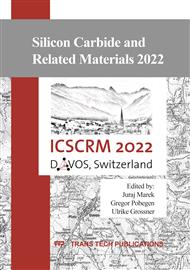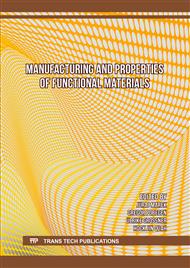[1]
H. Fujiwara, T. Kimoto, T. Tojo, and H. Matsunami, Characterization of in-grown stacking faults in 4H-SiC (0001) epitaxial layers and its impacts on high-voltage Schottky barrier diodes, Appl. Phys. Lett., 87 (2005) 051912.
DOI: 10.1063/1.1997277
Google Scholar
[2]
H. Matsunami, and T. Kimoto, Step-controlled epitaxial growth of SiC: high quality homoepitaxy, Mater. Sci. Eng. R Rep., 20 (1997) 125-166.
DOI: 10.1016/s0927-796x(97)00005-3
Google Scholar
[3]
T. Höchbauer, C. Heidorn, and N. Tsavdaris, New SiC Epitaxial Growth Process with Up to 100% BPD to TED Defect Conversion on 150mm Hot-Wall CVD reactor, Mater. Sci. Forum, 963 (2019) 123-126.
DOI: 10.4028/www.scientific.net/msf.963.123
Google Scholar
[4]
N. Zhang, Y. Chen, E. K. Sanchez, D. R. Black, and M. Dudley, The Effect of 4H-SiC Substrate Surface Scratches on Chemical Vapor Deposition Grown Homo-Epitaxial Layer Quality, Mater. Sci. Forum, 615 (2009) 109-112.
DOI: 10.4028/www.scientific.net/msf.615-617.109
Google Scholar
[5]
M. Sasaki, H. Matsuhata, K. Tamura, K. Sako, K. Kojima, H. Yamaguchi, and M. Kitabatake, Synchrotron X-ray topography analysis of local damage occurring during polishing of 4H-SiC wafers, Jpn. J. Appl. Phys., 54 (2015) 091301.
DOI: 10.7567/jjap.54.091301
Google Scholar
[6]
K. Ashida, D. Dojima, Y. Kutsuma, S. Torimi, S. Nogami, Y. Imai, S. Kimura, J. Mizuki, N. Ohtani, and T. Kaneko, Evaluation of Polishing-Induced Subsurface Damage of 4H-SiC (0001) by Cross-Sectional Electron Backscattered Diffraction and Synchrotron X-Ray Micro-Diffraction, MRS Adv., 1 (2016) 3697-3702.
DOI: 10.1557/adv.2016.433
Google Scholar
[7]
K. Ashida, D. Dojima, S. Torimi, N. Yabuki, Y. Sudo, T. Sakaguchi, S. Nogami, M. Kitabatake, and T. Kaneko, Rearrangement of Surface of 4°Off-Axis 4H-SiC (0001) Epitaxial Wafer by High Temperature Annealing in Si/Ar Ambient, Mater. Sci. Forum, 924 (2018) 249-252.
DOI: 10.4028/www.scientific.net/msf.924.249
Google Scholar
[8]
Kwansei Gakuin University, Toyota Tsusyo Corporation. (March 1, 2021). Kwansei Gakuin University and Toyota Tsusyo Develop Innovative Process that Achieves "Zero Defects" in 6-Inch SiC Substrates – Supply of Samples to Device Manufacturers to Begin to Facilitate Early Mass Production [Press release]. https://global.kwansei.ac.jp/cms/kwansei_en/researchspotlight/202110 20_プレスリリース英文02.pdf
DOI: 10.46679/978819484836310
Google Scholar



